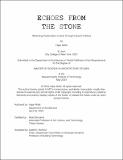Echoes From the Stone Reframing Preservation in Syria Through Haurani Folklore
Author(s)
Alrifai, Hajar
DownloadThesis PDF (184.5Mb)
Advisor
Sinnokrot, Nida
Terms of use
Metadata
Show full item recordAbstract
Partially buried in the landscape of Hauran in southern Syria, my family’s 1500-year-old house, Alali—formerly a Byzantine church—further erodes with each passing year. Throughout the decades, the house has been subjected to various forms of destruction: from development, demolition, and rocket strikes to violent reconstruction. Its crumbling stones are laden with the memories of four generations and echo with a way of life that is disappearing. At the heart of Hauran are the fellahin, farmers who permanently settled in its villages in the late 19th century. As they settled, the fellahin reclaimed, inhabited, dismantled, and rebuilt the Byzantine structures, often rearranging or reimagining the original programs: chapels, houses, and cemeteries. In my family’s border village of Nasib—a place both liminal and at the margin—this rich local history lives not in formal archives but in scattered material like architectural ruins, oral poems, folk songs, diasporic transcripts, and 8mm video cassettes, many of which resonate as sonic artifacts. What began as a project of documenting the decay of our old house evolved into a meditation and manifesto on preservation outside the purview of top-down institutions. Through creative writing and cinematic intervention, Echoes from the Stone asks: what does it mean to preserve a place, and preservation for whom? In this proposed paradigm, ‘story’ becomes integral to architectural preservation. This story of Alali interweaves my journal entries with the encounters of my greatgreat grandfather, Hassan Ali, an oral poet who founded the village. I further draw from my grandfather Faisal’s diaries, our family’s archival videos, and interviews with Nasib’s elders, including my grandmother Um Ghazi, an olive farmer, and Um Saado, a Bedouin matriarch and shepherd who once lived in the old home with her family. By foraging for this counter-archive of living memories, I reveal intergenerational intersections which complicate and reimbue the colonial history of the village—and of Syria—with voices that echo from the stone, voices that persist and whisper from the ground, from across borders and oceans, and from within. This interdisciplinary chronicle draws from architecture, agriculture, literature, anthropology, and film, to reconstruct a social history of the village and speculate on alternate ways of dwelling, building, and preserving— reclaiming the archive, reinserting narrative, and reframing heritage through the folklore of Hauran.
Date issued
2024-05Department
Massachusetts Institute of Technology. Department of ArchitecturePublisher
Massachusetts Institute of Technology